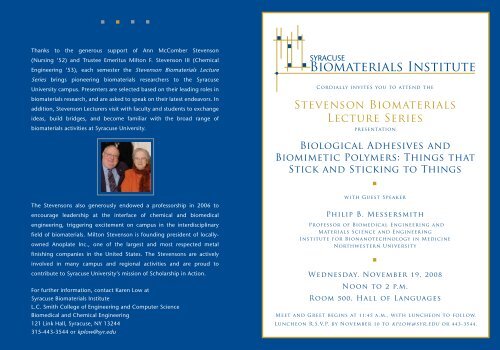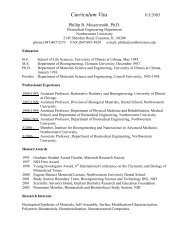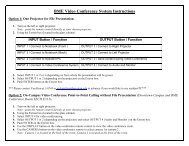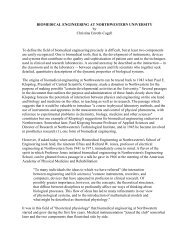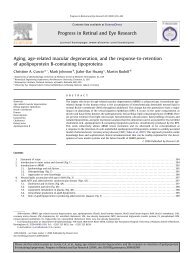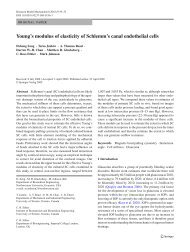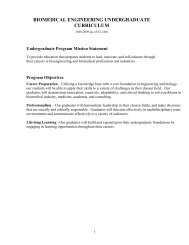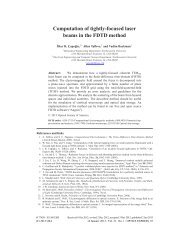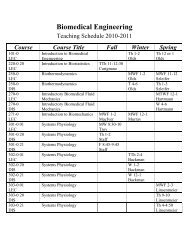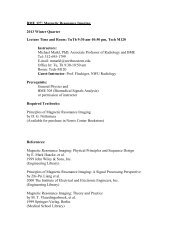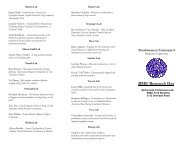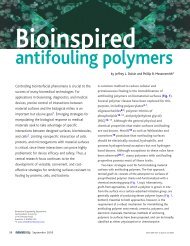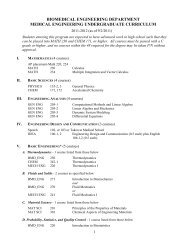0003794P BMCE Invite.indd - Phillip B. Messersmith Research Group
0003794P BMCE Invite.indd - Phillip B. Messersmith Research Group
0003794P BMCE Invite.indd - Phillip B. Messersmith Research Group
Create successful ePaper yourself
Turn your PDF publications into a flip-book with our unique Google optimized e-Paper software.
Thanks to the generous support of Ann McComber Stevenson<br />
(Nursing ‘52) and Trustee Emeritus Milton F. Stevenson III (Chemical<br />
Engineering ‘53), each semester the Stevenson Biomaterials Lecture<br />
Series brings pioneering biomaterials researchers to the Syracuse<br />
University campus. Presenters are selected based on their leading roles in<br />
biomaterials research, and are asked to speak on their latest endeavors. In<br />
addition, Stevenson Lecturers visit with faculty and students to exchange<br />
ideas, build bridges, and become familiar with the broad range of<br />
biomaterials activities at Syracuse University.<br />
Cordially invites you to attend the<br />
Stevenson Biomaterials<br />
Lecture Series<br />
presentation<br />
Biological Adhesives and<br />
Biomimetic Polymers: Things that<br />
Stick and Sticking to Things<br />
The Stevensons also generously endowed a professorship in 2006 to<br />
encourage leadership at the interface of chemical and biomedical<br />
engineering, triggering excitement on campus in the interdisciplinary<br />
field of biomaterials. Milton Stevenson is founding president of locallyowned<br />
Anoplate Inc., one of the largest and most respected metal<br />
finishing companies in the United States. The Stevensons are actively<br />
involved in many campus and regional activities and are proud to<br />
contribute to Syracuse University’s mission of Scholarship in Action.<br />
For further information, contact Karen Low at<br />
Syracuse Biomaterials Institute<br />
L.C. Smith College of Engineering and Computer Science<br />
Biomedical and Chemical Engineering<br />
121 Link Hall, Syracuse, NY 13244<br />
315-443-3544 or kplow@syr.edu<br />
with Guest Speaker<br />
Philip B. <strong>Messersmith</strong><br />
Professor of Biomedical Engineering and<br />
Materials Science and Engineering<br />
Institute for Bionanotechnology in Medicine<br />
Northwestern University<br />
Wednesday, November 19, 2008<br />
Noon to 2 p.m.<br />
Room 500, Hall of Languages<br />
Meet and Greet begins at 11:45 a.m., with luncheon to follow.<br />
Luncheon R.S.V.P. by November 10 to kplow@syr.edu or 443-3544.
The Speaker<br />
Biological Adhesives and<br />
Biomimetic Polymers: Things that<br />
Stick and Sticking to Things<br />
<strong>Phillip</strong> B. <strong>Messersmith</strong>, Ph.D., is a professor of biomedical engineering and<br />
materials science and engineering at Northwestern University. He earned a<br />
B.S. degree in life sciences in 1985 and a Ph.D. degree in materials science and<br />
engineering in 1993, both from the University of Illinois at Urbana. Before coming<br />
to Northwestern University, <strong>Messersmith</strong> was a postdoctoral fellow at Cornell<br />
University, and was a faculty member at the University of Illinois at Chicago<br />
(1994-1997). <strong>Messersmith</strong>’s research interests include biological adhesion,<br />
bioinspired synthesis of materials, polymeric biomaterials, tissue engineering,<br />
biomineralization, self-assembly, and nanostructured materials. Current research<br />
projects include studies of biological adhesives, including mussel adhesive<br />
proteins and gecko adhesives, the design of biomimetic adhesive polymers,<br />
development of novel biomaterials for regenerative medicine, and antifouling<br />
polymer surfaces. His awards and honors include young investigator awards from<br />
the Whitaker Foundation and the National Institutes of Health (NIH), and a MERIT<br />
award from the NIH. <strong>Messersmith</strong> is a fellow of the American Institute for Medical<br />
and Biological Engineering and a member of the editorial boards of Soft Matter,<br />
Nanomedicine, Biointerphases, and Biomedical Materials.<br />
<strong>Phillip</strong> B. <strong>Messersmith</strong>, Ph.D.<br />
Professor of Biomedical Engineering and<br />
Materials Science and Engineering<br />
Institute for Bionanotechnology in Medicine<br />
Northwestern University<br />
In nature there exist a great variety of interesting adhesive strategies that<br />
operate in wet and dry environments and that can serve to inspire the<br />
development of new materials. Marine mussels, for example, have evolved<br />
sophisticated protein glues that serve to securely immobilize the organism<br />
on rocks and such man-made structures as piers and ship hulls. The proteins<br />
found in these glues have specialized amino acid compositions, undoubtedly<br />
related to the particular challenges of achieving permanent adhesion in the<br />
wet marine environment. In contrast, geckos achieve temporary adhesion<br />
in dry environments using rather ordinary keratin (hair) proteins, taking<br />
advantage of weak transient chemical interactions with surfaces. In this talk,<br />
I will focus on these two remarkable but contrasting adhesive strategies,<br />
and illustrate how they can inspire the development of novel synthetic<br />
functional materials.


